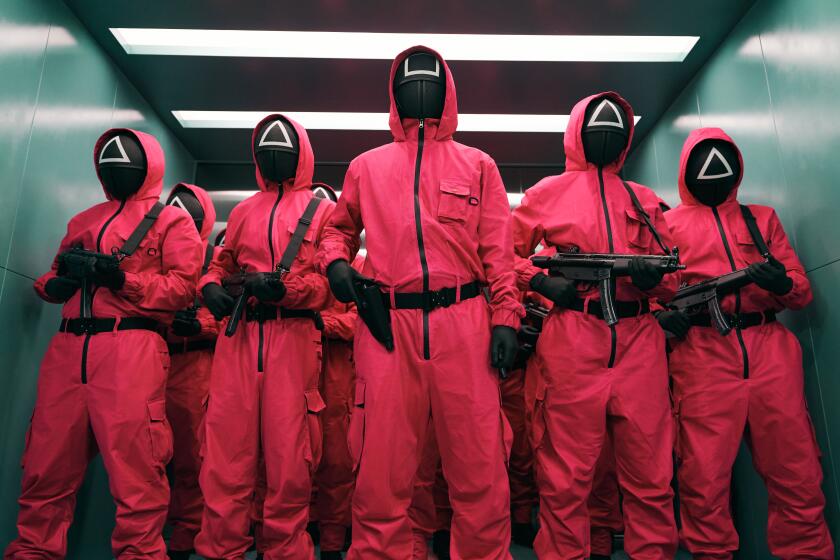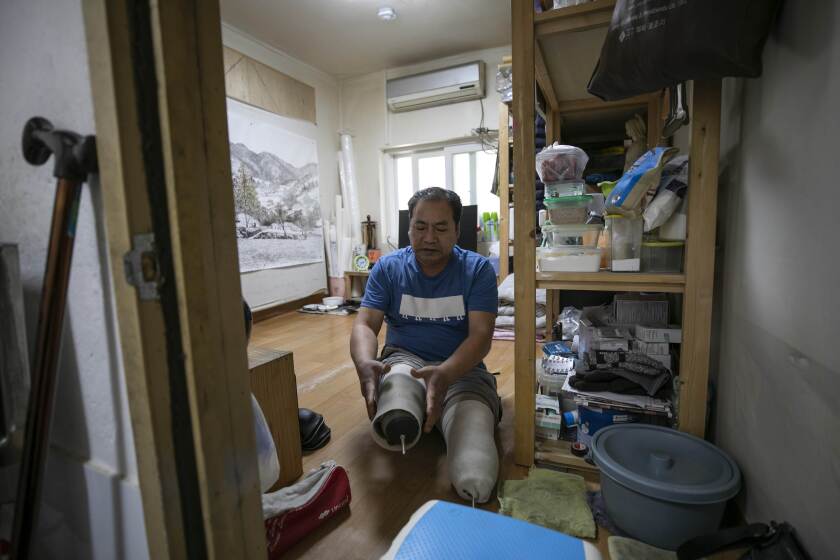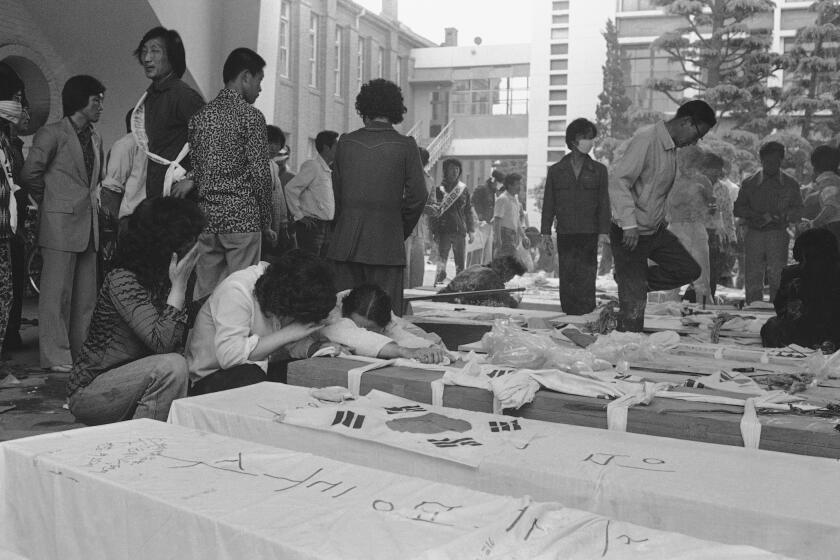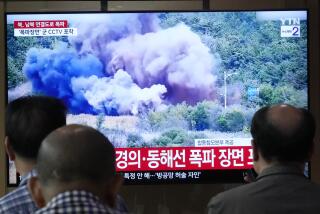North Korea fires its first intercontinental ballistic missile in three months
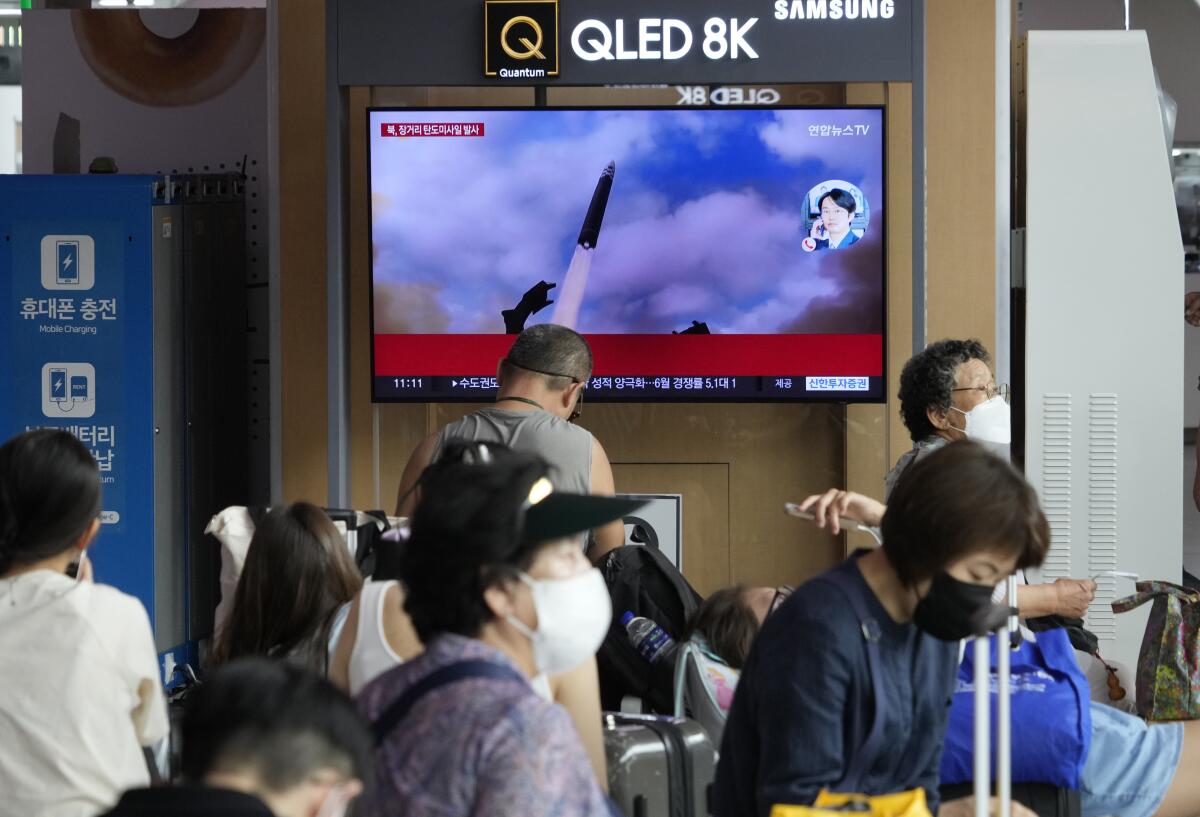
- Share via
SEOUL — North Korea test-fired its first intercontinental ballistic missile in three months Wednesday, days after it threatened “shocking” consequences to protest what it called provocative U.S. reconnaissance activity near its territory.
Some experts say North Korea likely launched its developmental, road-mobile Hwasong-18 ICBM, a type of solid-fuel weapon that is harder to detect and intercept than its liquid-fuel ICBMs. North Korean leader Kim Jong Un previously called the Hwasong-18 the most powerful weapon of his nuclear forces.
The missile, fired from North Korea’s capital region around 10 a.m., flew about 620 miles at a maximum altitude of 3,730 miles before landing in waters between the Korean Peninsula and Japan, according to South Korean and Japanese assessments. They said the missile was launched at a high angle in what observers say was an apparent attempt to avoid neighboring countries.
Japanese Chief Cabinet Secretary Hirokazu Matsuno said the missile flew for 74 minutes — the longest flight time recorded by any weapon launched by North Korea. The previous record of 71 minutes was registered during the test flight of the liquid-fuel Hwasong-17 ICBM last year.
South Korean content is likely to become even more important to Netflix it seeks to weather the Hollywood writers’ strike. But many writers and producers in the country feel exploited by the streaming giant.
South Korea’s military called the launch “a grave provocation” and urged North Korea to refrain from additional launches. Matsuno denounced North Korea’s repeated missile launches as “threats to the peace and safety of Japan, the region and international society.”
In a trilateral phone call, the chief nuclear envoys of South Korea, Japan and the United States agreed to sternly deal with North Korean provocations and boost their coordination to promote a stronger international response to North Korea’s nuclear and missile programs, according to Seoul’s Foreign Ministry.
The launch came while South Korean President Yoon Suk Yeol and Japanese Prime Minister Fumio Kishida were attending the NATO summit in Vilnius, Lithuania. In an emergency meeting of South Korea’s security council convened by video in Lithuania, Yoon warned North Korea would face more powerful international sanctions due to its illicit weapons programs.
North Korea’s ICBM program targets the mainland United States, while its shorter-range missiles are designed to hit U.S. regional allies such as South Korea and Japan.
Since 2017, North Korea has performed a slew of ICBM tests, but some experts say the country still has some technologies to master to possess functioning nuclear-armed missiles capable of reaching major U.S. cities.
Seoul has fewer people living on the streets than Los Angeles. But tens of thousands live in illegal units so small there is barely enough space to lie down.
North Korea’s ICBM test in April was the first launch of the Hwasong-18. After that launch, Kim said the missile would enhance North Korea’s counterattack capabilities and ordered the expansion of his country’s nuclear arsenal to “constantly strike extreme uneasiness and horror” in its rivals.
Missiles with built-in solid propellants would be easier to move and hide, making it difficult for opponents to detect their launches in advance. All of North Korea’s previous ICBM tests used liquid fuel.
Kim Dong-yub, a professor at the University of North Korean Studies in Seoul, said Wednesday’s launch appeared to be North Korea’s second flight-test of the Hwasong-18.
Earlier this week, North Korea released a series of statements accusing the United States of flying a military spy plane close to its soil.
In a statement Monday night, Kim’s sister and top advisor, Kim Yo Jong, warned the United States of “a shocking incident” as she claimed that the U.S. spy plane flew over North Korea’s eastern exclusive economic zone eight times earlier in the day.
The United States and South Korea dismissed North Korea’s accusations and urged it to refrain from any acts or rhetoric that raised animosities.
As South Korea confronts a dark chapter of its history, a former soldier’s quest for repentance becomes a lesson in the fragility of memory.
“I would just say that we continue to urge [North Korea] to refrain from escalatory actions,” Matthew Miller, a spokesperson for the U.S. State Department, said Tuesday. “As a matter of international law, [North Korea’s] recent statements that U.S. flights above its claimed exclusive economic zone are unlawful are unfounded, as high seas freedoms of navigation and overflight apply in such areas.”
North Korea has made numerous similar accusations over U.S. reconnaissance activities, but its latest statements came amid heightened animosities over North Korea’s torrid run of weapons tests since the start of last year. Some observers say North Korea wants to use an expanded weapons arsenal to wrest greater concessions in eventual diplomacy with its rivals.
“Kim Yo Jong’s bellicose statement against U.S. surveillance aircraft is part of a North Korean pattern of inflating external threats to rally domestic support and justify weapons tests,” said Leif-Eric Easley, a professor at Ewha University in Seoul. “Pyongyang also times its shows of force to disrupt what it perceives as diplomatic coordination against it — in this case, South Korea and Japan’s leaders meeting during the NATO summit.”
Kim Dong-yub, the professor, said Wednesday’s launch was likely made under North Korea’s previously scheduled weapons buildup programs to hone Hwasong-18 technologies, rather than a direct response to the NATO gathering or the alleged U.S. spy plane flight.
As South Korea hits the world’s lowest birth rate, a rural elementary school struggles to stay open amid a nationwide drop-off in school-age children.
The Hwasong-18 is among an array of high-tech weapons that Kim Jong Un has vowed to introduce to deal with what he called escalating U.S. military threats. Other weapons on his wish list are an ICBM with multi-warheads, a spy satellite and a nuclear-powered submarine. In late May, North Korea’s launch of its first spy satellite ended in failure, with the rocket carrying it plunging into the ocean soon after liftoff.
Some experts say North Korea might ramp up weapons tests around July 27, the date for the 70th anniversary of the signing of an armistice that ended the 1950-53 Korean War. North Korea calls the date “the V-Day” or “the War Victory Day.”
“Pyongyang might be manufacturing tensions ahead of its Victory Day to further strengthen solidarity domestically after having failed its first spy satellite launch in May, and then justifying future provocations by first unleashing a stream of threats and harsh rhetoric about U.S. spy planes,” said Duyeon Kim, an adjunct senior fellow with the Center for a New American Security.
U.N. Security Council resolutions ban North Korea from engaging in any launches using ballistic technologies. But China and Russia, both permanent members of the council, blocked the United States’ and others’ attempts to toughen U.N. sanctions on North Korea over its recent ballistic missile tests.
Yamaguchi reported from Tokyo.
More to Read
Sign up for Essential California
The most important California stories and recommendations in your inbox every morning.
You may occasionally receive promotional content from the Los Angeles Times.
